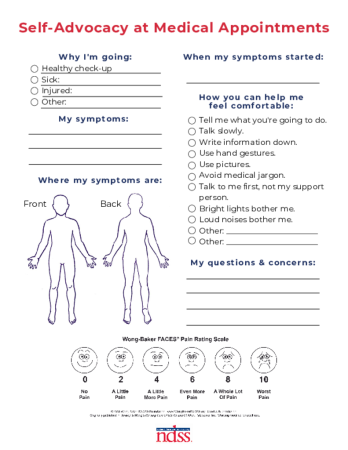Self-advocacy doesn’t just apply to governmental policies. It also includes making needs and preferences known in all the environments of everyday life. Self-advocacy at healthcare appointments often holds significant importance for individuals with Down syndrome because of the empowerment and autonomy that can be felt when actively participating in one’s own healthcare decisions. This enhances an individuals’ feeling of dignity and strengthens independence.
Going to appointments, whether they are with a primary care provider, specialist, or dentist, can be intimidating. Many people feel nervous during appointments, which can make communicating more difficult. Sometimes healthcare professionals might seem rushed or use words that are difficult to understand. Finding ways to effectively share concerns, preferences, and symptoms can lead to more accurate diagnoses from medical professionals as well as more appropriate treatment plans.
To help prepare individuals with Down syndrome to advocate for themselves at healthcare appointments, NDSS has created a printable two-sided worksheet that can be filled out at home prior to the appointment. The individual will be prompted to answer questions about the purpose of the appointment, symptoms and their location, when the symptoms started, preferences for receiving information, sensory sensitivities, and a visual pain scale. The opposite side has space for the individual, their support person, or the medical professional to write notes and draw pictures or diagrams during the appointment.
Bringing this completed worksheet to healthcare appointments will make communication with medical professionals easier and more effective. Thank you to the Wong-Baker FACES Foundation for allowing use of their Wong-Baker FACES Pain Rating Scale.
Quick tips:
- When making an appointment, ask to schedule at the beginning or end of the day when the office may be less crowded.
- If it is helpful, bring along a second person to take notes during the appointment.
- Alert staff if alternative or augmentative communication is preferred.
- Request some of the lights in the exam room be turned off while waiting for medical staff to arrive.
- Waiting rooms can be crowded and noisy. Ask to wait in a different location if the area is too overwhelming.
- Have the staff explain and/or demonstrate the steps of the procedure before occurring, especially if it involves touch, startling noises, bright lights, or discomfort.
- Bring along small comforting items such as headphones, a stuffed animal, a stress ball, or a handheld video game.
- Don’t be afraid to ask medical staff to speak more slowly, repeat themselves, or explain something in greater detail.
- Write down or type questions ahead of time.
- Ask staff if recording audio is allowed during the appointment. This will allow an opportunity to listen again if any information is forgotten or unclear.
- Before leaving, confirm the next steps of your treatment plan (scheduling a follow up appointment, seeing a specialist, starting a medication, etc.).
- If needed, schedule an appointment with another medical professional for a second opinion.








